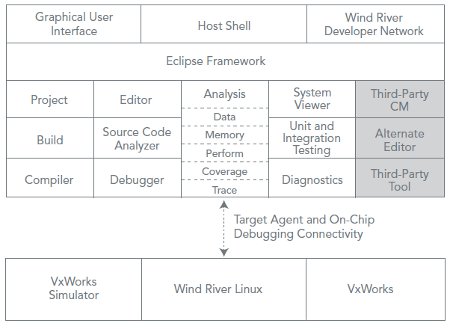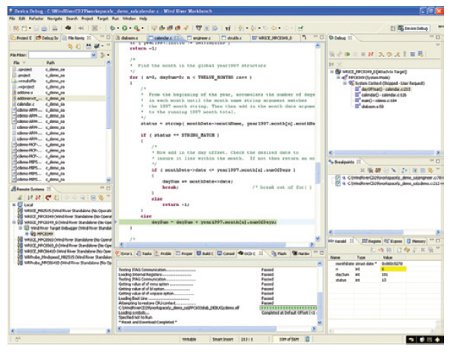Wind River tool suite upgraded for multi-core
Feb 2, 2010 — by Eric Brown — from the LinuxDevices Archive — 43 viewsWind River has rev'd its embedded development tool-suite for Linux and VxWorks. Upgraded software is said to include: the Wind River Workbench 3.2 integrated development environment, now synchronized with Eclipse 3.5; the JTAG-based Wind River On-Chip Debugging 3.2, which adds multi-core and multi-target support; and the Wind River Compiler 5.8.
The Wind River Workbench integrated development environment (IDE) is billed as "a fully integrated end-to-end, open standards-based collection of tools for device software design, development, debugging, testing and management." Workbench 3.2 is designed to support the latest versions of both the market-leading Wind River Linux commercial embedded development distribution and Wind River's VxWorks real-time operating system (RTOS).

Wind River Workbench architecture
(Click to enlarge)
Wind River On-Chip Debugging 3.2
Wind River Workbench provides the foundation for Wind River Workbench On-Chip Debugging 3.2, an extensible JTAG solution that combines the On-Chip Debugging IDE with one of two available hardware-based debug units. Developers can choose either the high-performance, multicore-capable Wind River ICE 2 or the entry-level, USB-based Wind River Probe. Wind River On-Chip Debugging is said to support the latest 32-bit and 64-bit processors based on ARM, Coldfire, Intel, MIPS, and PowerPC architectures.

Wind River Workbench On-Chip Debugging interface
(Click to enlarge)
With version 3.2, On-Chip Debugging users can now visualize and perform run-control operations on multiple target systems, CPU cores, and kernel objects within a single windowed environment, says Wind River. The debug tools can even expose the inner workings of kernel objects such as threads, tasks, and processes, says the company. Both Wind River ICE 2 and Wind River Probe utilize JTAG acceleration technology, which is claimed to optimize the use of JTAG interface bandwidth for improved performance.
Wind River Compiler 5.8
Billed as an OS-agnostic tool-suite, Wind River Compiler comprises a C/C++ compiler, an assembler, a linker, ANSI C and C++ libraries, and an instruction set simulator, says Wind River. Formerly known as the "Diab" compiler, Wind River Compiler has been widely used in mission-critical applications, such as automotive under-the-hood, industrial, and aerospace and defense systems, says the company.
Both Wind River Workbench On-Chip Debugging 3.2 and the new Wind River Compiler 5.8 add support for the following processors:
- Power Architecture e200 core-based automotive controllers from STMicroelectronics and Freescale
- Select Intel Xeon and Intel Core 2 Duo general purpose embedded processors
- Freescale QorIQ P4080 networking processors
- Cavium Networks Econa processors
- Freescale i.MX51 and i.MX25 multimedia application processors
- RMI Alchemy Au1300 media processors
Availability
Wind River Workbench 3.2 (supporting Wind River Linux 3.0.2 and VxWorks version 6.8), as well as Wind River On-Chip Debugging 3.2 and Wind River Compiler 5.8 are available now at an undisclosed price. More information may be found here.
This article was originally published on LinuxDevices.com and has been donated to the open source community by QuinStreet Inc. Please visit LinuxToday.com for up-to-date news and articles about Linux and open source.